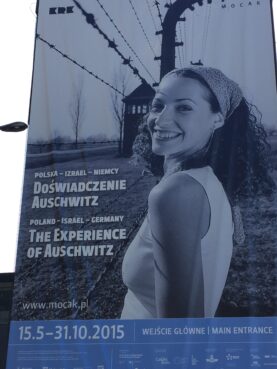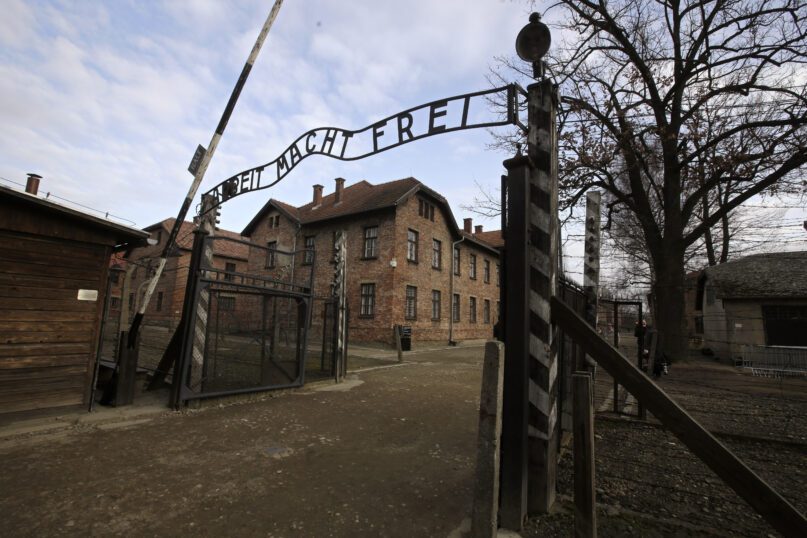Eight summers ago, I went on a pilgrimage to Poland — to visit Jewish sites, and especially, Nazi concentration camps. And, especially, Auschwitz-Birkenau.
By the time our visit was over, we were hot, tired, hungry, and thirsty. We went back on the bus, and stopped at a roadside snack bar in the town of Oswiecim.
Because, no — there were no refreshments outside the gates of the death camp.
No one expected that there should have been refreshments outside the gates of the death camp.
Consider, then, the backlash on a new commercial venture outside Auschwitz.
From the Times of Israel:
Commemoration professionals in Poland have criticized the opening of an ice cream stand just outside the museum on the grounds of the Auschwitz-Birkenau former death camp.
The stand – its walls emblazoned with a drawing of an ice cream cone and a pink-colored logo reading “icelove” as well as the words “waffles” and “ice creams” – opened this month about 200 meters away from — and in plain view of — the iconic, red-brick Auschwitz II Historical Gate, also known in Poland as the “Death Gate,” with its double train tracks and overhead watch post.
A county official said that the stand had been erected without a permit and would be moved.
The criticisms have come, fast and furious. “Tasteless.” “Disrespectful.” “Awful.”
All of those appellations are true.
But, barely hidden beneath those denunciations of inappropriateness lies something even more interesting, and redemptive.
It is about the fate of the sacred.
if there was one thing that I learned in the university — the hidden curriculum, the class they don’t require, but which is required nevertheless — it is this.
Nothing is holy. No time, no place, and certainly, no texts and no ideas.
In a world where we sometimes wonder “Is nothing sacred?” — the way that we respond to the presence of an ice cream concession at Auschwitz reveals that yes, some things are sacred.
Sometimes, we only recognize that something is holy when we sense that it is being profaned.
The beautiful city of Krakow is the largest major city to Auschwitz. It is, therefore, the departure site for trips to Auschwitz.
What, then, shall we make of this poster, advertising such a trip?

I understand the social psychology of using attractive people to “sell” “stuff.”
But, let us ask: What “stuff”, or product, is this poster “selling?”
More than that: What is an attractive, apparently physically fit woman doing in a poster that is advertising “the experience of Auschwitz?”
What is the subliminal message here? That the beautiful people are visiting Auschwitz? Or, even worse: that they could have been found at Auschwitz?
If you are reacting negatively to the idea of ice cream at Auschwitz, and if you are reacting negatively to that poster, then congratulations. You harbor within yourself a religious propensity that many theologians thought that our culture had irretrievably lost.
You recognize that Auschwitz is a sacred place.
For, what is the holy?
On the one hand, holy means set aside and special, but a special kind of special. There is a special kind of numinous quality. A place of the mysterium tremendum, a huge and sacred mystery, a sense of awe.
Not because they are naturally beautiful; anyone can experience awe at sunrise in the Rockies. But, because of a cultural association that makes them holy.
For example: For me, the holiest place in America is the Lincoln Memorial — because of the “presence” of the martyred president, and its physical setting.
Yes, I felt awe at Auschwitz. Notice how I described my Poland trip in the first paragraph. I did not refer to it as a “trip” or a “tour.” I called it a “pilgrimage.”
But, the awe that I experienced was not because I felt the presence of God there. Quite the opposite.
The late theologian, author, and book seller, Arthur Cohen, referred to the Holocaust as the tremendum, a manifestation of sheer awe — although utterly without the presence of God.
Standing on the steps of the bombed gas chamber, I said to myself: I have been to axis mundi, the very spiritual center of the world, the Temple Mount in Jerusalem.
This is its polar opposite — anus mundi, which I trust I need not translate.
But, there is another dimension to the holy.
It is that sense of kodesh or kedusha.
How do we define the holy? One definition will suffice for our purposes.
The holy is that which we cannot use.
It is why the Talmud forbids us to use the Temple Mount in Jerusalem as a thoroughfare; the same is true of the synagogue.
It is why we are forbidden to use the lights of the Hanukah menorah by which to see, even if there is a power failure. “These lights are holy”– in a way that even Shabbat candles are not.
And, if we cannot use that which is holy, then we certainly cannot exploit it — which means that the holy should be immune to the forces of market capitalism.
Shabbat is holy for many reasons. But, especially, because it is a “useless” day. Nothing “happens.” But, especially, especially because of the prohibition on handling money on Shabbat.
You can have holiness, or you can have consumer culture — but you cannot have the two of them at the same time, and in the same place.
The push back on ice cream at Auschwitz is not merely an aesthetic issue.
Nor is it merely an issue of taste.
It is actually the recognition that there is holiness in this world, and in a civilization that often mocks the holy, this is a good thing.
This has been my quest for my entire career — the restoration of the quality of the holy in Jewish life.
I have consistently taught the idea that there are holy times, such as Shabbat and the holidays.
There are holy places — the home. The Holy of Holies in the Jewish home is the table, which is the substitute for the altar in the ancient Temple. Synagogues are holy places. The land of Israel is holy. Jerusalem is holy (the implications of this holiness being too large for me to explain here, but I assure you that it keeps me up at night).
And yes, paradoxically, concentration camps are holy places. The paradox: they are holy because they were the sites of the industrialized profanation of the image of God.
The theologian Emil Fackenheim was right. He said that in the wake of the Shoah we have a 614th commandment: not to hand Hitler any posthumous victories.
The worst posthumous victory of them all would be to fail to see that life contains numberless opportunities of seeking transcendent meaning and holiness.
I will go one step further.
There should be no refreshments at Auschwitz, or any other concentration camp, because the mere presence of refreshments mocks the suffering of those who died in the camps.
You expect to be hungry and thirsty (and perhaps you have a health condition wherein hunger and thirst would be dangerous). Bring a snack, and bring bottled water.
But, to expect to purchase food and drink at Auschwitz seems — if not sacrilegious, then at least grossly jarring.
You’re hungry? You’re thirsty?
With all due respect, your hunger and your thirst cannot compare to the hunger and the thirst of the 1.3 million — Jews, Poles, labor leaders, priests, Roma, homosexuals, Soviet POWS, and others — who were interned here.
The Passover Haggadah enjoins us — to see ourselves as if we, personally, had emerged from Egypt.
Is it possible that the modern mitzvah would be for us to see ourselves — as if we, personally, had emerged from Auschwitz?






